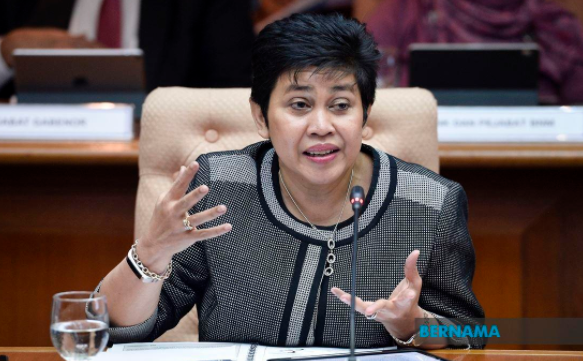KUALA LUMPUR: Following is the transcript of Bernama’s email interview with Bank Negara Malaysia (BNM) Governor Tan Sri Nor Shamsiah Mohd Yunus on the newly-launched Financial Sector Blueprint 2022-2026 unveiled recently, as well as the country’s economy in general.
1. Digitalisation has been a key transformation for financial institutions for quite some time. What kind of advancement does the central bank aim to see with the launch of the Blueprint? Will this include policies on cryptocurrency?
We would like to see more ‘digital first’ solutions in financial services. Many aspects of our lives are now done online and digitally. This has only become more widespread following the pandemic. Whether it is remote working, buying food or shopping, more and more people are used to being able to do these things anytime, anywhere, at the click of a button. Since the pandemic, these behaviours have only become more common.
Thus, we want Malaysians to have digital options in finance. Some examples are fully digital claims experiences for insurance and takaful, and seamless payments for day-to-day transactions.
Let me be clear: this is not about forcing customers to go digital. Rather it is about offering people choices. Physical and hybrid options will still be available. The point is that consumers and businesses who are ready for the technology should be able to benefit from it.
As the regulator, our priority is to foster the right conditions for Malaysia’s financial sector to make the most out of digitalisation, while ensuring that attendant risks are well understood and managed effectively by financial institutions. This reflects the rapidly changing landscape of technology, which makes it almost impossible for anyone to predict the shape and form of the next waves of changes.
Enabling competition and innovation will thus be a key focus. This will see the introduction of new digital players, as well as enhanced pathways to test and scale digital innovations. This will include efforts to help accelerate the growth of fintech, especially Islamic fintech, such as for trade-related solutions, alternative finance, social finance, and sustainable finance. Alongside this, we will also put in place safeguards to
preserve fair consumer outcomes and manage risks to the system, such as those related to cybersecurity.
We will also aim to futureproof key infrastructures that serve as the backbone of the digital economy. This includes ensuring that real-time payment systems, data infrastructures and standards can cater to a wide range of players and use cases in the financial sector. This also reflects the landscape today, which is becoming more diverse.
Like many central banks around the world, we are paying close attention to the digital asset space, and the opportunities and risks that come with it. As with any emerging development, our goal is to ensure that the way we regulate and supervise continues to effectively serve our monetary and financial stability mandates. That remains unchanged.
We are also going one step further by experimenting with central bank digital currencies (CBDCs) over the next few years. After all, there is no better way to keep pace with something new than to try it ourselves.
This is a really exciting space, with many promising ideas and a lot going on. But I want to be clear that we don’t want to simply get caught up in all the hype and buzz.
Therefore, in our exploratory efforts we will prioritise use cases that have higher upsides for Malaysia. This is consistent with our approach to digital innovation. We do not promote technology for its own sake. Rather, it must deliver tangible benefits to the economy.
2. On cybersecurity, there were concerns constantly raised over illegal financial schemes (fraud/scam) and cyber attacks in our financial system. How does Bank Negara address this in the Blueprint to ensure prudent and responsible conduct in the financial system?
Cyber threats continue to loom, as more and more business and financial transactions are done online. These same technologies that benefit consumers and businesses are also vulnerable to issues such as operational disruptions, data breaches and fraud.
And so our priority is to ensure that Malaysians feel confident, safe and secure in using financial services, including digital financial services.
Digital financial services involve complex chains and networks of relationships involving many different firms, infrastructures, devices and users. Everyone in the chain has a role to play to protect the system against cyber threats.
On our part, we will ensure that the financial industry adheres to a strong set of minimum standards. For example, our policy on Risk Management in Technology (RMiT) requires financial institutions to adopt robust practices and controls that are in line with leading practice and international standards.
We have also put in place the Financial Sector Cyber Threat Intelligence Platform (FinTIP). It is a round-the-clock industry cyber threat intelligence platform that collects, aggregates, analyses, and disseminates cyber threat intelligence between financial institutions and other key stakeholders. This rapid information sharing and collaboration will strengthen the financial industry’s response capabilities to the evolving cyber threats affecting the financial system.
We need to subject all financial institutions to a high standard and to continuously raise them, as criminals continue to up their game. We are also mindful that the chain is only as strong as its weakest link. We don’t want weak links to be exploited which will in turn affect the wider financial system.
This is why we are also intensifying our focus on cyber security at the ecosystem level, given the various interlinkages between the financial sector and the rest of the economy.
This means looking at linkages with critical third party service providers (TPSPs), which can give rise to systemic risks. We will also work closely with relevant parties, including law enforcement agencies, to share actionable cyber security intelligence that will enable swift, effective and coordinated responses to identified threats.
On top of strengthening defences, we also believe that it is critical to foster cyber security readiness and responsiveness. And so, what is equally important is that financial institutions have in place the necessary arrangements to recover quickly or minimise the impact if breaches occur. While we try to minimise the risk of it happening, the reality is cyber attacks will happen from time to time. If and when such attacks happen against financial institutions, customers should be assured that they won’t be adversely impacted.
We also recognise the importance of awareness-building and education among consumers about cyber risks. Here, we continue to support nationwide efforts to strengthen digital literacy and cyber hygiene practices among financial consumers. This includes to be aware of threats such as scams, financial fraud and identity theft, and knowing how to protect against them. For this, we expect financial institutions and other
relevant parties like consumer and trade associations to regularly educate their customers about basic “do’s and don’ts”, and best practices to keep their accounts safe and secure.
3. When do you plan to announce the winners of digital banks?
We are at an advanced stage of assessing applications and target to notify all applicants by end March. But what I can say for now is that the application process was very competitive. We received 29 applications. Alas, we will only be able to license a maximum of five, and so we need to thoroughly evaluate each and every single application.
Not only must successful applicants comply with prudential requirements. The law also demands that the licensing of an applicant would be in the best interest of Malaysia, which in this case, is to advance financial inclusion through the use of innovative technologies and continue to promote financial stability.
We want digital banks to offer relevant products and services to unserved and underserved segments that can help people and entrepreneurs realise their financial goals, be it to own assets and save for the future, or to grow their business.
In addition, we also expect the entry of digital banks to accelerate the digitalisation of incumbent banks. This will be good not just for the industry, but also for customers, as this would help raise customer standards and product offerings across the board, including for those who continue to bank with incumbents.
4. Among key expected outcomes from the latest Blueprint include providing meaningful choice and access for consumers. Can you elaborate how the new Blueprint would benefit the consumers and what meaningful choice that BNM intends to see?
We believe that consumers should be empowered to make their own financial choices, and as you say, meaningful choices. For this to be realised, a number of conditions need to be met. I want to highlight three.
The first is diverse choices. Like I said, we want to foster a healthy competition in our financial sector. This will be key to ensure that there are options for consumers to choose from. This encourages financial institutions to be proactive in addressing pain points faced by their customers, or to innovate to attract new ones -- including those that may not be served by existing solutions or players. To complement this, we will explore ways to make it easier for financial consumers to shop around and switch from one provider to another -- which will reinforce market discipline.
The second is about enabling well-informed financial decisions. This means consumers making financial decisions fully aware of what those decisions entail, including of any cost, risk or responsibility associated with those decisions. We will continue to build on financial education efforts, particularly through the Financial Education Network (FEN).
These will go beyond the availability and awareness about financial education solutions, such as information, tools and other resources. Rather, the goal will be to help financial consumers understand how better financial decision-making can improve and enrich their lives. Like the RUMAHKU module that AKPK introduced in January 2019. In less than 12 months, 25,682 participants went through the education module. And after realising the responsibility and cost of taking a housing loan, 10 per cent of those who have completed the RUMAHKU module opted to postpone their initial plan of buying a house. This makes it much more likely for consumers to act upon the knowledge that they gain from these financial education solutions. These efforts will also be supported by annual Key Performance Indicators (KPIs), as part of a longer-term goal to increase Malaysia’s financial literacy scores in international surveys, such as those by the Organisation for European Economic Co-operation (OECD).
The third is to ensure that fair consumer outcomes continue to be preserved. We will continue to strengthen standards of conduct applied to financial institutions, and to reinforce them with the use of supervisory and enforcement levers where necessary. A major area of focus here will be to reform the conduct regulatory architecture in Malaysia. These include enacting the proposed Consumer Credit Act (CCA) to address any inconsistencies in the level of oversight and protection accorded to borrowers across banks and other non-bank financial providers.
And one notable proposal under the CCA is to establish a Consumer Credit Oversight Board to serve as an independent conduct authority to oversee consumer credit providers which are not currently subject to conduct regulation.
These outcomes will not be achieved overnight, and will also need to be continuously refined over time. What is important is that we continue to work towards the desired end-game -- where consumers are confident and capable to take charge of their finances.
5. Sustainable economic growth can only happen within the context of preserving monetary and financial stability. Will promoting ESG (environmental, social and governance) criteriabe one of Bank Negara’s key focuses in the next five years?
The sustainability agenda has gained significant global traction in recent years. This has been advanced under various banners -- the triple bottom line, ESG, stakeholder capitalism, among others.
For Bank Negara Malaysia, promoting sustainable development has always been a key priority for us. After all, it is cemented in our mandates -- which is to promote monetary and financial stability conducive to Malaysia’s sustainable economic growth.
For this reason, we’ve been working on strategies to position the financial system to facilitate an orderly transition to a greener economy, which we also talk quite a bit on in the Blueprint.
First, to integrate climate-related and environmental risks in how we regulate and supervise the financial system. Here, the priority is to promote a climate-resilient financial sector. We expect financial institutions to be more active in assessing, measuring, managing, and disclosing climate and environment-related risks.
For this, our work on a Climate Change and Principle-based Taxonomy, and Reference Guide on Climate Risk Management and Scenario Analysis will help financial institutions embed climate factors into their business and operations. The Joint Committee on Climate Change (JC3) -- comprising BNM, the SC (Securities Commission Malaysia) and the industry -- will be a key driver to lead and initiate firm climate actions for the financial industry, including to ensure that the Taxonomy is implemented consistently and credibly.
We also expect financial institutions to provide meaningful support to their clients and customers. This may include sharing of expertise, best practices or other resources to ease financial consumers -- be it individuals or businesses -- in their journey to adopt greener practices.
Second, to support an orderly transition to a low-carbon economy. It will be important that financial sector’s activities are aligned with the national strategy. An important part of this is to scale up green finance. This will see us working together with industry players and other stakeholders to support the funding needs required for Malaysia’s transition towards becoming a net zero nation.
Third, climate-related risks are embedded across all functions within BNM, where environmental impact is always a key consideration for any decision-making. Operationally, we make conscious effort on waste reduction, responsible sourcing and more to reduce our carbon footprints.
6. The floods further solidify the need for ESG adaptation. There has been a substantial number of announcements on these by Malaysian banks, but is it up to the mark or suffice?
The recent floods are a powerful demonstration and reminder as to the need to take the sustainability agenda seriously.
Malaysian banks are taking efforts to integrate ESG considerations in their governance, business strategy, operations, and risk management. This is being reinforced by regulatory measures such as the Climate Change and Principle-based Taxonomy and upcoming guidance on risk management, and scenario analysis that has been issued for consultation. Some banks have started analysing exposures in their lending and investment portfolios, and then engaging customers where there are ESG concerns. We are also seeing more and more banks supporting their customers transition to more sustainable practices, including by offering solutions and advice.
These are just baby steps, and there is still a lot more work to be done. But in this area, we are confident that the banking industry is moving in the right direction and that momentum will continue to pick up.
7. Would the on-going assistance/moratorium for those affected by floods impact the banks profits/dividend?
Let me first say that the past two years have been an extraordinarily challenging period for many Malaysians. As it is, the pandemic had already disrupted many lives and livelihoods. For those affected by the floods, it has only become even more challenging. The financial sector has stepped up to provide various forms of assistance to those affected by the floods, not just to provide repayment assistance but to also waive fees and charges to replace lost or damaged bank documents.
Any such assistance will entail a cost, but this will be manageable as flood-related exposures are expected to be moderate. Further, the banking industry has also been gradually building up their provisioning levels since 2020 to buffer for further adverse impact from the pandemic. Taken together, we do not expect a sudden surge in credit costs and this would contain any significant impact on bank earnings.
On this, I also want to emphasise that banks are able to provide this assistance while managing their bottom lines and depositors’ interest, only because of decades of efforts to strengthen governance and risk management in the financial sector. This financial discipline has in turn helped the financial system diversify its risks and build up buffers over the years. It is vital that we continue to preserve the strength of Malaysia’s financial sector, so that it remains effective in absorbing further shocks or vulnerabilities to the economy and continues to play a key countercyclical role during periods of crisis.
8. What is the central bank’s assessment and outlook for the year, first and second half with the emergence of new variants and borders that remain largely closed?
For 2022, the Malaysian economy is expected to improve further, underpinned by continued expansion in global demand and higher private sector expenditure. The current official forecast is for growth to expand between 5.5-6.5 per cent. The Bank will be announcing our latest assessment on the economy in March.
Malaysia is well-positioned to gain as global growth and trade bounce back, as observed last year. Strong external demand for electrical & electronics (E&E) products and commodities, particularly from Malaysia’s key trade partners, including China, the US, and the regional economies, will contribute to further expansion in export-oriented sectors.
Importantly, the broad-based improvement in overall income, employment conditions, and consumer sentiments would provide a lift to household spending.
Combined with more Malaysians getting their vaccinations and boosters where 97.9 per cent of the adult population has completed two doses of vaccinations and 50.8 per cent of them have also received the booster shots, the easing of restrictions will allow further normalisation in economic activity going into the first half of 2022. The recovery momentum is expected to strengthen further in the second half of 2022, as international
borders gradually reopen and global supply chain disruptions soften towards the end of the year.
Furthermore, the continuation of major investment projects in key economic sectors, such as in the E&E, manufacturing and digital investments would provide further lift to growth.
Nevertheless, risk to the outlook for 2022 remains. Such risks may arise from a weaker-than-expected global growth, worsening in supply chain disruptions, and the emergence of severe and vaccine-resistant COVID-19 variants of concern.
Meanwhile, headline inflation is likely to remain moderate in 2022 as the base effect from fuel inflation dissipates. Core inflation is expected to edge upwards, reflecting both demand and cost factors amid the economic reopening and some upward pressure from costs due to still elevated commodity prices.
Nevertheless, core inflation is expected to be modest, with the upward pressure contained by the continued slack in the economy and labour market. Overall, the inflation outlook continues to be subject to global commodity price developments and risks from prolonged supply-related disruptions.
9. There was an expectation that BNM would increase the Overnight Policy Rate (OPR) in the first monetary meeting, instead the central bank kept it unchanged at 1.75 per cent (since July 7, 2020). Does this mean a sustainable recovery has not set in? When can we expect policy normalisation?
Let me start by reiterating what we said in our January Monetary Policy Statement.
The Monetary Policy Committee (MPC) deems the current monetary policy stance to be appropriate and accommodative. Going forward, the domestic economy is projected to gradually recover amid modest price pressures. Given the prevailing uncertainties surrounding the pandemic and supply chain disruptions, among others, the MPC remains mindful of avoiding a premature withdrawal of policy support that could derail the economic recovery. Any adjustments to the degree of accommodation remain data-dependent.
With this in mind, we will continue to closely monitor signs of a more sustainable recovery in an environment of price stability, while paying attention to external developments.
I also want to reiterate the importance of optimising policy complementarities. As you know, the pandemic has highlighted and accelerated various structural changes. That’s why, supply-side and structural policies are pivotal to ensure a sustained recovery. This includes to support shifts to digitalisation and improve labour efficiency, including reskilling labour to manage labour mismatches. -- BERNAMA
NOTE: BNM is scheduled to announce Malaysia’s economic and financial developments in the fourth quarter of 2021 on Feb 11, 2022. - Bernama













